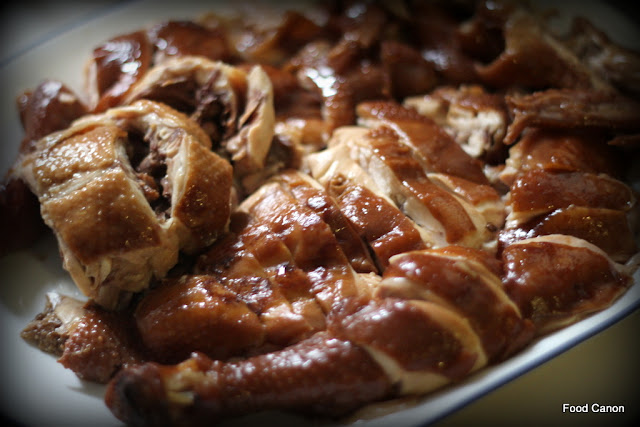Soy Sauce Chicken ("Si Yau Kai") Recipe
Serves 4-6
1 Chicken (about 1.5 kg)
Two bowls of light soy sauce
Half a bowl of thick dark soy sauce
Dashes of White Pepper
One bowl of Rock Sugar
2-3 stalks of Spring Onions, Cut into 1-2 inch lengths
2-3 inch ginger, lightly pounded
20 cloves of garlic, lightly bruised (if you like garlic, by all means, use more)
Aromatics: 2-3 Star Aniseed, 1 Cinnamon Stick
Herbs: Scallions, cilantro stem and roots
3 bowls of water
Optional - 3 lemon peels, 2 liquorice sticks (ganchao)
Garnishing: Cilantro and Spring Onions
Accompaniment: Boiled eggs, sliced cucumber, Bean Curd (Tau Kwa)
Chilli sauce: Fresh Chillies, Lime, Sugar, and a bit of oil
Note: I am suggesting that you are make more sauce then you need as this means you do not need to turn the chicken around and minimise the chance of tearing the skin. You want to poach the whole chicken at one go. The leftover sauce can be reused again.
Method
- Heat up your rice cooker or pot.
- Add some oils and dump the aromatics, herbs and garlic bulbs in. Fry for about 2 minutes till fragrant (i.e you smell something nice :)).
- Add the sauces. Simmer for about half an hour to develop the flavours.
- Once the sauce is done, put the chicken in. Add water to ensure the chicken is floating in the pot. You may need to use a wire rack to push the chicken in. If it is not in contact with the sides, the skin will not break.
- If you are using a normal pot, control the fire. Put in on a very low simmer. I prefer to use the rice cooker because the warm function holds the temperature well. Cook the chicken within the range of 72 to 80°C for 90 minutes. If you use too high a heat and boil the chicken constantly, the meat will release more juices resulting in drier meat. And of course the skin will tear. The first sign that the chicken is overcook is torn skin. I use a thermometer to monitor the temperature. Switch the rice cooker to cooking mode, letting the temp hit about 78C and then put it on warm mode. Once it go down to 72C, switch to cooking mode. I am sure you can get the idea. Depending on the types of pot you have, you can of course experiment various ways of cooking the chicken within the temp range. Thermal Pots are also good for this. If the chicken is small, an hour will work.
- After it is done, take the chicken out and let it rest till it comes down to room temp. At this stage, it is still gently cooking inside. To test whether the chicken is cook, stick something sharp into the thigh meat. If the juice is clear, it is done. If pink, poach some more. It is up to your personal preference. Some like the thigh meat pink.
- Remove some of the sauce and cook it further in another pot., You may want to make it sweeter. Thicken it with some corn flour. You may need to strain the finished to separate out the residual bits.
- Chop the chicken. This is an art in itself. After all the careful cooking to keep the skin perfect, you don't want to mess it up for the dining table. Use a sharp cleaver (ie. sharpen it!). Cut off the thighs and wings first. Separate to larger pieces, smash lightly and do a quick cleaver chop. Hmm...I will show you on to do this in another post as visuals will be more helpful. You can also google and there are many cooks out there who will demo on how to chop up a chicken.
The leftover sauce can be reused for another lot of chicken. I boil the eggs alongside the chicken (you do not need boiling temperature to make hard boiled eggs!). Peel the eggs and dump them back to the sauce so that they get a nice brown color. As for the Tau Kwa, they do impart a sour taste if left too long in the sauce. I prefer to separate out a portion of the sauce and braise them separately.
The great thing about this dish is after you have made the sauce, it can be reused again. The second time round will be easier as the sauce is well flavoured and good to go to serve a second tour of duty. You can also use the sauce to braise pork belly or trotters. Boil the sauce first before you keep it in the fridge.
Serve with steamed rice, the condiments on the side and add the rest of the cilantro leaves on the plated chicken pieces.The whole cilantro is used - nothing is thrown away.You can also add cucumber, the faithful companion to this dish. And of course some fried shallots will be good too. Enjoy.
Remember, it is important that the chicken is not overcooked. Poach gently...slow and low. If you have a Sous Vide appliance, use it and it is the most convenient way for precision temp control. If not , using the rice cooker alone works well too.
Tell me if this recipe works for you.




No comments:
Post a Comment